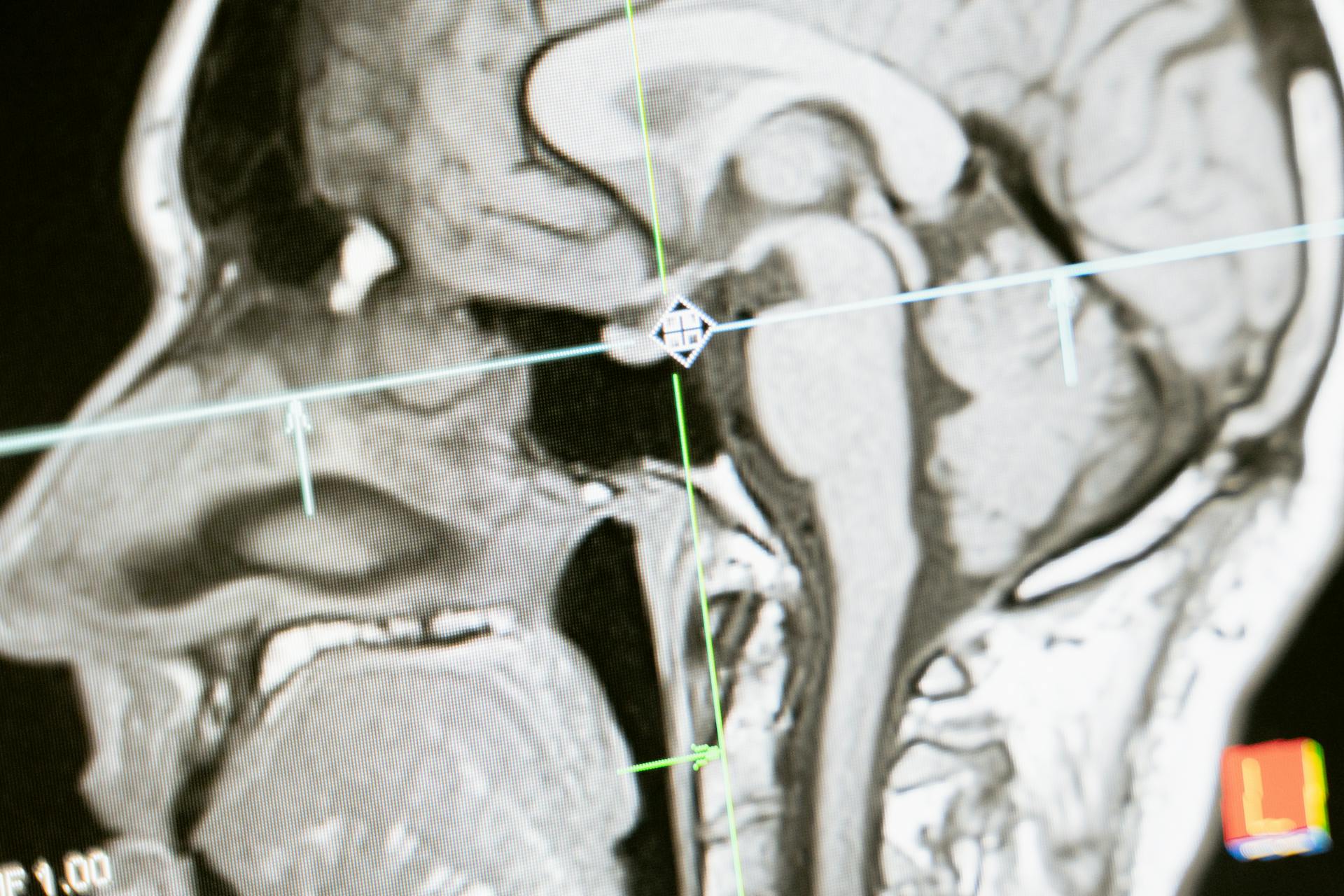
Water on the brain in dogs, also known as hydrocephalus, is a serious condition that affects many canine companions.
The condition occurs when there's an accumulation of fluid in the brain, which can put pressure on the brain and cause a range of symptoms.
This can happen due to various reasons, including congenital defects, infections, or injuries that cause the fluid to build up.
In severe cases, hydrocephalus can lead to seizures, loss of coordination, and even death.
Dogs with hydrocephalus often exhibit unusual behavior, such as pacing back and forth, restlessness, and irritability.
What is Hydrocephalus?
Hydrocephalus is a condition where there is a buildup of cerebrospinal fluid in a dog's brain, placing pressure on the brain and potentially leading to brain damage and death.
This condition is often congenital, meaning a dog is born with it, but it can also develop later in life. In fact, about 90% of dogs with hydrocephalus have the congenital form, which is caused by abnormalities in the structures that carry cerebrospinal fluid.
Some breeds are more prone to congenital hydrocephalus, including Chihuahuas, Cavalier King Charles spaniels, Boston terriers, and Pugs, among others.
The effects of congenital hydrocephalus can be severe, and symptoms may include abnormal walking, changes in behavior, and loss of vision. Affected dogs may also experience circling or falling over on one side, and may press their head into the floor or against the wall.
Acquired hydrocephalus, on the other hand, develops when the flow of cerebrospinal fluid is blocked or altered by infection, tumor, or swelling. The most common cause of acquired hydrocephalus is a brain tumor.
Here are some common causes of hydrocephalus in dogs:
- Blockage or obstruction of normal cerebrospinal fluid drainage
- Decreased cerebrospinal fluid absorption
- Excessive cerebrospinal fluid production
- Brain tumors
- Swelling due to infection, inflammation, or trauma
If left untreated, hydrocephalus can lead to neurological disease and even death. Early detection and treatment are crucial for preventing these complications.
Causes and Origins
Hydrocephalus in dogs is a complex condition that can arise from various causes. It's a serious issue that affects many breeds, but some are more prone to it than others.
Congenital hydrocephalus is a birth defect that's often associated with a dome-shaped skull, a large fontanelle, and eyes that appear to gaze downward. This condition is more common in certain breeds, such as Chihuahuas, Cavalier King Charles spaniels, and Boston terriers.
Acquired hydrocephalus, on the other hand, can develop at any age due to a blockage of the cerebrospinal fluid, often caused by a brain tumor or swelling. This type of hydrocephalus can affect any breed of dog.
Some breeds are more susceptible to hydrocephalus due to their skull shape. Breeds with dome-shaped heads, such as Chihuahuas, Pomeranians, and Bulldogs, are more prone to this condition.
Here are some breeds that are more likely to develop hydrocephalus:
- Chihuahua
- Cavalier King Charles spaniel
- Boston terrier
- Maltese
- Pomeranian
- Yorkshire terrier
- English bulldog
- Pug
- Toy poodle
- Lhasa apso
- Pekingese
It's essential to be aware of the signs and symptoms of hydrocephalus, which can include abnormal walking, changes in behavior, circling, and loss of vision. If you suspect that your dog is suffering from hydrocephalus, it's crucial to seek veterinary attention promptly.
Symptoms and Signs
Symptoms of hydrocephalus in dogs can be quite varied and may not always be immediately apparent. Some dogs may not show any symptoms at all.
The pressure in the brain caused by hydrocephalus can lead to noticeable physical and behavioral changes in dogs. These can include a dome-shaped skull, wide-set eyes, and unusual posture.
Dogs with hydrocephalus may also exhibit unusual gait or spastic walking, and some may fall over to one side. In some cases, hydrocephalus can cause difficulty learning and house training.
Here are some common signs of hydrocephalus in dogs:
- A dome-shaped skull
- Wide-set eyes
- Unusual posture
- Unusual gait or spastic walking
- Falling over to one side
- Difficulty learning and house training
It's worth noting that not all dogs with hydrocephalus will display all of these symptoms, and some may not show any noticeable signs until around 8 to 12 weeks old.
See what others are reading: Why Do Dogs Stop Drinking Water
Signs and Symptoms
Dogs with hydrocephalus may display a range of physical and behavioral signs.
Some dogs may have a dome-shaped skull, which is a distinctive characteristic of the condition.

Wide-set eyes are another common sign of hydrocephalus in dogs.
Inability to settle and compulsive circling are also behaviors that may be seen in dogs with hydrocephalus.
These signs can be subtle, and not all dogs will exhibit them right from birth. In fact, most dogs will show signs of hydrocephalus around 8 to 12 weeks old.
Dogs with hydrocephalus may also have unusual posture, head pressing, or an unusual gait or spastic walking.
Falling over to one side can also be a sign of the condition.
Some dogs may experience slow growth, increased vocalization or excitement, or neurological symptoms.
Difficulty learning and house training is a common issue, affecting 75% of all dogs with hydrocephalus.
Here are some physical signs of hydrocephalus in dogs:
- Dome-shaped skull
- Wide-set eyes
- Unusual posture
- Head pressing
- Unusual gait or spastic walking
- Falling over to one side
It's worth noting that not all dogs with hydrocephalus will display these signs, and some may require additional testing, such as an ultrasound or MRI, to confirm the diagnosis.
Eye Issues
Eye issues in puppies with congenital hydrocephalus can be quite noticeable, often presenting with lateral deviation of the eyes, where both eyes are directed towards one side. This can be a clear sign of the condition.
Some puppies might even exhibit the "setting sun sign", where their eyes are abnormally directed downwards. This is a specific characteristic that owners should be aware of.
Blindness is also a possible symptom, which can be a challenging experience for both the puppy and its owner.
Check this out: Dogs Eyes Water When Eating
Diagnosis
A veterinarian can often diagnose congenital hydrocephalus in dogs by the distinctive head shape and symptoms of the puppy.
Most often, a vet will order an ultrasound or CT of the puppy's head to confirm the diagnosis.
A large open fontanel and lack of coordination when walking can give your veterinarian an idea of what to look for.
An ultrasound evaluation of the fontanel will show dilation of the brain ventricles.
A CT scan or MRI scan will determine the exact source of the fluid build up.
Tumors or other abnormalities will be seen on the various scans being performed.
In cases of suspected acquired hydrocephalus, CT or MRI is necessary to make a definitive diagnosis.
Electroencephalography (EEG) may also be used to help diagnose hydrocephalus.
The presence of a large open fontanel is usually a key indicator of hydrocephalus in young dogs.
A veterinarian will look at the clinical symptoms to help determine the severity of the hydrocephalus.
Recommended read: How Often Should You Change Your Dog's Water?
Frequently Asked Questions
How long do dogs live with water on the brain?
Dogs with mild to moderate hydrocephalus can live normal lives, while those with severe cases may have a shortened lifespan and potentially die suddenly
How do you treat water on a dog's brain?
Treatment for hydrocephalus in dogs typically involves medication to reduce cerebrospinal fluid (CSF) production or surgery to drain excess fluid. A VP shunt surgery can be performed to relieve pressure on the brain by diverting CSF to the abdomen.
Sources
- https://www.thesprucepets.com/hydrocephalus-in-dogs-5101169
- https://www.geniusvets.com/pet-care/learn/dogs/medical-resources/diseases-and-conditions-what-do-when-your-dog-has-water-brain
- https://vcahospitals.com/know-your-pet/hydrocephalus-in-toy-breed-puppies
- https://wagwalking.com/condition/hydrocephalus
- https://www.walkinpets.com/blog/hydrocephalus-in-dogs/
Featured Images: pexels.com


